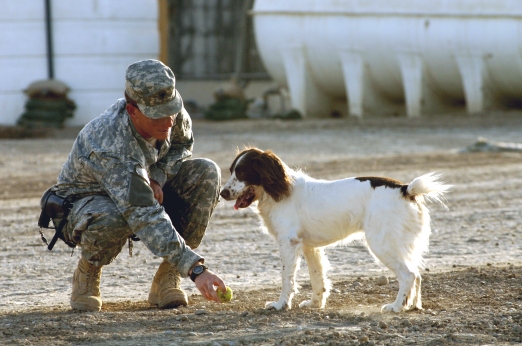Debuted in August of 2013, Animal Planet’s show : Glory Hounds is definitely a must watch in everyones books. Journalist and filmmakers from the special production crew follow and document the journey of military working dogs in some of the most volatile regions of Afghanistan.
It almost took a year for the network to gain access into special area combat zones which make it all the more intriguing to follow! Did you know that the camera teams over six week training just to catch up with the soldiers? Amazing right!
As the show follows the stories of different cases and friendships, each one reminds us of just how important these animals are to our troops who are overseas. Military working dogs should not only be seen as the brave heroes of our frontline force but also the ones who make a difference to protecting our borders overseas. The sad truth is that like all troops who fight and sacrifice their lives for the country, many return changed forever and maybe won’t even return at all.
Military working dogs are definitely not only surplus equipment that is used by the military, just like any other ordinary soldier but with four paws instead of two feet. Lets look at Air Force Staff: Sergeant Len Anderson and his working dog Azza.
Anderson never had imagine that he and Azza would end up in the frontline and combat zone after being deployed. The German Shepard was able to pick up any sound and hint of dangerous bombs whist doing their regular patrols. It was one time where he lost six fingers and severe trauma to his leg after a roadside bomb had been detonated. Although he had his left hand amputated after this experience, he will never forget the day Azza had save his life. If he had walked any further he would have lost his life.
The pair are recovering well and insure that the injuries will not deter them from continuing their work. it is encouraging to head that Anderson is now serving to help continue training and working with the K-9 team.
“Any time a dog saves a life, whether it’s just the handler or the troops behind her, that puts you in a whole different category with the dogs…Once they save a life, that’s a soldier standing there beside us. It’s not a dog anymore. They’re never a piece of equipment. They’re a fellow soldier. They just have a different dangerous job, and they can’t shoot a gun.”

Sourced from original story from HLNTV
G.C






 It is estimated that over the span of their service, a military solider will save over 150 soldiers lives. These animals are not only the furry heroes in the frontline force but also brace service animals who also deserve a respectable name. According to figures from the Ministry of Defence, over 807 military working dogs have been killed in America, due to the same excuse that has been repeated over and over again.
It is estimated that over the span of their service, a military solider will save over 150 soldiers lives. These animals are not only the furry heroes in the frontline force but also brace service animals who also deserve a respectable name. According to figures from the Ministry of Defence, over 807 military working dogs have been killed in America, due to the same excuse that has been repeated over and over again.
